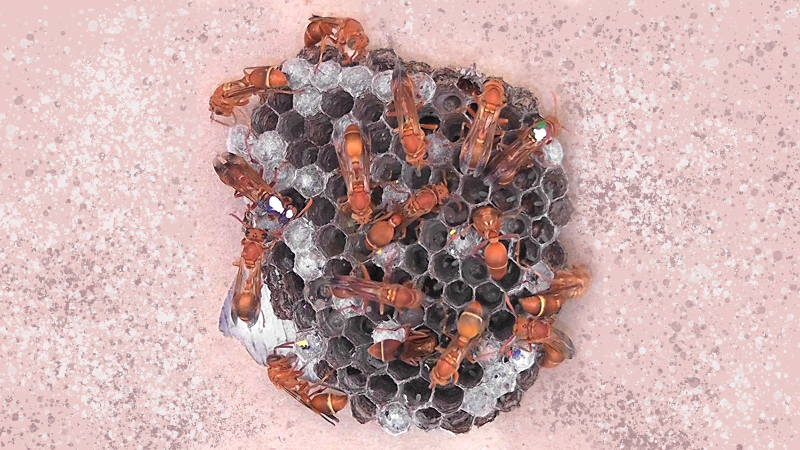
A colony of the tropical paper wasp Ropalidia marginata with a few individuals uniquely colour coded for identification (picture credit Nitika Sharma)
The paper wasp Ropalidia marginata, like many ants and bees, is a eusocial insect. In a colony, wasps are organised into groups or ‘castes’ that do different types of work. The queen of a wasp colony is the only female that lays eggs and reproduces, whereas the other females are workers who do not reproduce. The queen produces chemicals that she rubs on the surface of the nest to signal her role and presence to the other wasps.
When the queen wasp dies or is removed from the colony, one of the female workers steps into her role. This replacement female is called the ‘potential queen’. When she takes over, she becomes very aggressive for a short while, attacking and chasing the other wasps, and then calms down. This aggressiveness is not to fight off the competition to become queen but to accelerate her ovarian development to start laying eggs. The other wasps seem to recognise the potential queen innately and do not challenge her.
However, as long as the queen is in residence, the identity of the potential queen is a mystery to human observers. Unlike many other social insect species, we cannot tell which individual will take over the queen’s role based on any indicators like size, behaviour, how closely she is related to the queen or whether she has mated with males. The potential queen is revealed to us only when she takes over as queen and shows hyper-aggressive behaviour.
A team of scientists from the Indian Institute of Science (IISc), Bengaluru, and the University of California Los Angeles, USA, may have solved this mystery. The study was published in the journal Animal Behaviour and funded by the Department of Science and Technology (DST) and Council for Scientific Research (CSIR), India, the National Institute of Health (NIH) and the National Science Foundation (NSF), USA.
The researchers studied the behaviour of wasp colonies in the IISc campus and noted how many times four kinds of social interactions happened between the wasps. When the researchers combined the information from these different interactions, they could accurately identify the potential queen but not when they considered each interaction separately.
The researchers marked the wasps to identify each individual; they set up cameras around the wasp nests to record videos of the wasp colonies. The researchers considered four types of social interactions between the wasps in each colony for their study: i) how much space the wasps shared; ii) aggressive encounters like attacking or chasing; iii) exchanging liquid food, and iv) exchanging solid food. The video recordings showed how frequently any individual wasp showed one of these social interactions and how many other wasps it interacted with.
Next, the researchers combined the information about the social interactions into two networks: an ‘aggregate network’ where they added up the total number of interactions of each wasp; and a ‘multilayer network’ where they counted each interaction separately.
So, for example, if wasp A had an aggressive encounter and an exchange of liquid food with wasp B, this counted as only one interaction in the aggregate network because the same individuals, A and B, were involved in both aggression and exchange of liquid food. But in the multilayer network, this would count as two interactions instead of one, as two behaviours were involved. In this way, the multilayer network preserved the differences between the social interactions, whereas the aggregate network did not.
Based on the video recordings, the researchers assigned counts to each wasp for the number of times a wasp showed each of the four social interactions; the sum from the aggregate network, which lumps them together regardless of the social situation; and the sum from the multilayer network, which differentiates the interactions in the four situations. The question was, which one of these counts predicted the identity of the potential queen?
Once the researchers completed these calculations, they removed the queens from the wasp nests so the potential queens would reveal their identities through aggressive behaviour, and they could check their predictions. Surprisingly, it was the multilayer network that made the most accurate prediction. The potential queen almost always had the highest count of interactions on the multilayer network. However, she could have any count, high or low, for the individual interactions and the aggregate network. Thus, the authors concluded that the potential queen was the centre of a multilayer social network.
Asked if the wasps use such a complex analysis to identify their potential queen, Dr Nitika Sharma, the first author of the study, clarifies: “We are not saying that wasps use multilayer networks to identify the potential queen. Maybe she can signal her status to her nestmates through other cues, such as odour. However, from our study, we are now able to find correlates of her status that allow us to identify her even in the queen's presence.”
The members of animal societies interact with each other in many different ways to survive and protect the group together. Through this study, scientists solved a long-standing mystery of identifying who inherits the role of a queen in a wasp colony by combining several different social interactions into a coherent whole instead of looking at the pieces of this puzzle in isolation. Such an approach allows a deeper understanding of how animal societies work.
This article has been run past the researchers, whose work is covered, to ensure accuracy.






